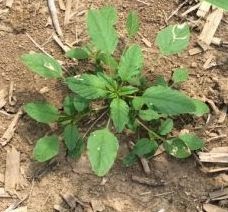Palmer amaranth (Amaranthus palmeri) continues to march across Kentucky. Initially this weed was thought to be present primarily in the west end of the state (Purchase region), but sightings have been reported within several Kentucky counties that border Tennessee and the lower Ohio River in the past few years.

Fig. 1 Young Palmer amaranth plant
Last year, Palmer amaranth was found on a farm in Hardin County and two additional fields in Mercer and Garrard counties. Last week a population of this weed was discovered in a corn field in Shelby County. These sightings would indicate that Palmer amaranth is a growing threat to grain crop production within the state.
How this weed specifically arrived on all these farms is yet to be determined. However, it is known that the seed of Palmer amaranth can be introduced when cotton hulls are fed to livestock and the subsequent manure spread on crop fields. Other possible routes for introduction can be from transport of farm equipment and trucks hauling supplies from the southern regions of the US where Palmer amaranth is widespread.
After Palmer amaranth becomes established it can be difficult to control. Many populations of this plant are known to be resistant to glyphosate. Crop producers across Kentucky need to be on the lookout for this weed in both soybean and corn fields.
Young Palmer amaranth plants can look similar to other pigweed species. This species has smooth stems and longer leaf petioles than other types of pigweeds. If you notice a plant that has this general appearance you may need to confirm its identification.
You can contact your local county extension office for assistance or to report its occurrence. Catching the presence of this weed before large populations become established in crop fields can help minimize a larger economic impact in the future.





